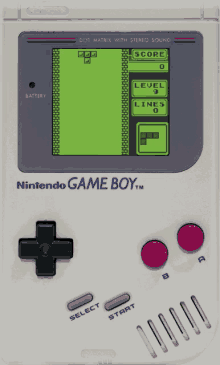
Rogers was told to pursue the rights, he approached Stein to seek rights for it to be distributed with the Game Boy. Arakawa questioned the idea, having planned to bundle Super Mario Land, but Rogers countered by stating that though a Mario game would promote the Game Boy to young boys, Tetris would promote it to everyone. Knowing Nintendo was planning to release the Game Boy, Rogers approached Nintendo of America president Minoru Arakawa to suggest Tetris as the perfect bundled launch game. Finding himself hooked to the game, he pursued the rights to publish Tetris in Japan, and secured licenses from both Spectrum HoloByte, who held the North American computer license, and Atari Games, which had produced the American arcade version under a sublicense from Mirrorsoft, which had the rights for the European computer market.
#GAME BOY TETRIS SCREEN SOFTWARE#
In 1988, Henk Rogers of Bullet-Proof Software noticed the US home computer version at the Las Vegas Consumer Electronics Show in a Spectrum HoloByte booth. The game was soon licensed by Andromeda Software executive Robert Stein, who sublicensed the game to multiple publishers in different territories. In 1988, Pajitnov teamed with fellow Soviet Academy of Sciences researchers Dmitry Pavlovsky, and Vadim Gerasimov to create a new two-player version of Tetris that ran on PCs. Tetris was first created in 1984 by Alexey Pajitnov. When a player scores a Double, Triple, or Tetris, incomplete rows of blocks are added to the bottom of the opponent's stack, causing it to rise.Īlexey Pajitnov, the designer of the original Tetris, called the Game Boy version his favorite.

Each player plays with a separate Game Boy and Tetris Game Pak, with the two consoles connected via the Game Link Cable. This version of Tetris includes a two-player mode, in which each player's objective is to remain in play for longer than his or her opponent. After completing a particular height, the player is treated to a cutscene of a rocket of various types being launched, eventually capping off with Russians dancing and the Buran shuttle being launched. The player may adjust the difficulty before beginning a game by selecting a starting level or choosing to pre-fill the play area with a given number of lines of randomly placed blocks. The level increases each time the player clears ten lines, as does the speed of falling tetrominoes. Points are awarded based on the current level and number of lines cleared. The player can normally see which block will appear next in a window off to the side of the playing field, but this feature can be toggled during the game. The game ends when at least part of a tetromino extends beyond the top of the playfield when setting in place.

As in most standard versions of Tetris, blocks do not automatically fall into open gaps when lines are cleared.Īs the game progresses, the tetrominoes fall faster. When one or more such lines are created, they disappear, and the blocks above (if any) move down by the number of lines cleared. The object of the game is to manipulate the tetrominoes by moving each one sideways and rotating it by 90-degree units with the aim of creating a horizontal line of blocks without gaps. A pseudorandom sequence of tetromino shapes, composed of four square blocks each, fall down the playing field, which is 10 blocks wide by 18 blocks high.

The Game Boy version of Tetris plays identically to versions on other platforms.


 0 kommentar(er)
0 kommentar(er)
